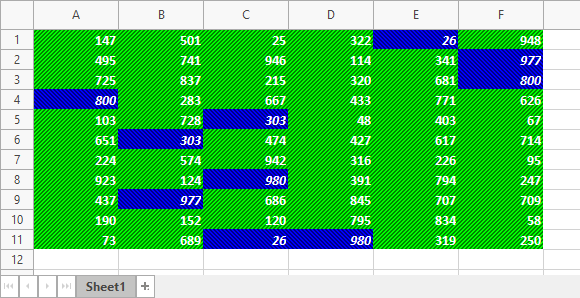TdxSpreadSheetConditionalFormattingRuleDuplicateValues Class
A Duplicate Values conditional formatting rule.
Declaration
TdxSpreadSheetConditionalFormattingRuleDuplicateValues = class(
TdxSpreadSheetConditionalFormattingRuleStyleBased
)Remarks
A Duplicate Values conditional formatting rule applies custom appearance settings to all cells that contain duplicate values within target areas. The Duplicate Values rule complements Unique Values.

Main API Members
The list below outlines key members of the TdxSpreadSheetConditionalFormattingRuleDuplicateValues class. These members allow you to configure Duplicate Values rule settings.
Common Rule API Members
- Areas
- Allows you to manage the conditional formatting rule’s target areas.
- Clone
- Copies the rule between different sets of target areas.
- Index | StopIfTrue
- Specify how the rule interacts with other conditional formatting rules applied to the same cells.
Duplicate Values Rule-Specific API Members
- Style
- Allows you to define the appearance of formatted cells.
General-Purpose API Members
- Assign
- Copies compatible settings between conditional formatting rules.
- BeginUpdate | EndUpdate
- Allow you to avoid excessive redraw operations during batch rule setting changes.
- GetDetails
- Returns the conditional formatting rule’s name displayed in the Conditional Formatting Rules Manager dialog.
- LoadFromStream | SaveToStream
- Allow you to store conditional formatting rule settings in a stream.
- Owner
- Provides access to the parent conditional formatting controller.
Create a Duplicate Values Rule
To create a Duplicate Values conditional formatting rule, you can call one of the overloaded Add procedures of the corresponding conditional formatting controller and pass a reference to the TdxSpreadSheetConditionalFormattingRuleDuplicateValues class as the ARuleClass parameter:
- TcxDataControllerConditionalFormatting.Add
- Creates a new conditional formatting rule for a Data Grid, Tree List, or Vertical Grid control.
- TdxSpreadSheetConditionalFormatting.Add
- Creates a new conditional formatting rule in a spreadsheet document.
Alternatively, you can call the constructor of the TdxSpreadSheetConditionalFormattingRuleDuplicateValues class and pass the target conditional formatting controller as the AOwner parameter.
Delete a Conditional Formatting Rule
To delete an individual Duplicate Values conditional formatting rule, you can do one of the following:
- Call the TdxSpreadSheetCustomConditionalFormatting.Remove procedure and pass the rule as a parameter.
- Release the rule directly in code (call the Free procedure in Delphi or use the
deletekeyword in C++Builder).
Alternatively, you can call the TdxSpreadSheetCustomConditionalFormatting.Clear procedure to delete all rules in a conditional formatting controller.
Other Style-Based Conditional Formatting Rule Classes
You can also use the following style-based rules to apply spreadsheet-compatible style settings to cells that meet specific conditions:
- TdxSpreadSheetConditionalFormattingRuleAboveOrBelowAverage
- An Above or Below Average conditional formatting rule.
- TdxSpreadSheetConditionalFormattingRuleCellIs
- A Cell Is conditional formatting rule.
- TdxSpreadSheetConditionalFormattingRuleExpression
- An Expression conditional formatting rule.
- TdxSpreadSheetConditionalFormattingRuleTopBottomValues
- A Top/Bottom Values conditional formatting rule.
- TdxSpreadSheetConditionalFormattingRuleUniqueValues
- A Unique Values conditional formatting rule.
Code Example: Create Duplicate and Unique Value Conditional Formatting Rules in Spreadsheet
The following code example creates Duplicate and Unique value conditional formatting rules with different custom cell styles and applies these rules to the last selected cell range in the active worksheet in a TdxSpreadSheet control:
var
ATableView: TdxSpreadSheetTableView;
ADuplicateValuesRule: TdxSpreadSheetConditionalFormattingRuleDuplicateValues;
AUniqueValuesRule: TdxSpreadSheetConditionalFormattingRuleUniqueValues;
begin
ATableView := dxSpreadSheet1.ActiveSheetAsTable;
if ATableView.Selection.Count = 0 then Exit;
ATableView.ConditionalFormatting.BeginUpdate; // Initiates the following batch change
try
ATableView.ConditionalFormatting.Add(ATableView.Selection.Area,
TdxSpreadSheetConditionalFormattingRuleDuplicateValues, ADuplicateValuesRule);
ADuplicateValuesRule.Style.Brush.BackgroundColor := clBlue;
ADuplicateValuesRule.Style.Brush.ForegroundColor := clNavy;
ADuplicateValuesRule.Style.Brush.Style := sscfsRevDiagonalStrip;
ADuplicateValuesRule.Style.Font.Color := clWhite;
ADuplicateValuesRule.Style.Font.Style := [fsBold, fsItalic];
ATableView.ConditionalFormatting.Add(ATableView.Selection.Area,
TdxSpreadSheetConditionalFormattingRuleUniqueValues, AUniqueValuesRule);
AUniqueValuesRule.Style.Brush.BackgroundColor := clLime;
AUniqueValuesRule.Style.Brush.ForegroundColor := clGreen;
AUniqueValuesRule.Style.Brush.Style := sscfsDiagonalStrip;
AUniqueValuesRule.Style.Font.Color := clWhite;
AUniqueValuesRule.Style.Font.Style := [fsBold];
finally
ATableView.ConditionalFormatting.EndUpdate; // Calls EndUpdate regardless of the batch operation's success
end;
end;

Indirect TdxSpreadSheetConditionalFormattingRuleDuplicateValues Class References
The TdxSpreadSheetCustomConditionalFormatting.Rules property references the TdxSpreadSheetConditionalFormattingRuleDuplicateValues class as a TdxSpreadSheetCustomConditionalFormattingRule object.
To access all public API members, cast the returned object to the TdxSpreadSheetConditionalFormattingRuleDuplicateValues class. You can call the rule’s ClassType function to identify the actual rule type.